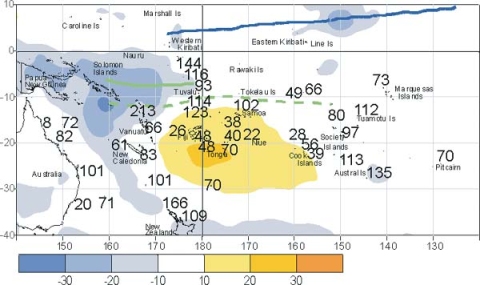Enhanced convection over Papua New Guinea and the Solomon Islands
Below average rainfall from Fiji to the Southern Cook Islands
In June, the SPCZ extended east from the Solomon Islands toward Tuvalu, being displaced north of its mean position in that region. However, it was virtually non- existent further east in the Southwest Pacific.
A large area of enhanced convection with areas of above average rainfall affected the region from the Solomon Islands west to Papua-New Guinea. In the north, the ITCZ was further south than usual, enhancing rainfall and cloudiness over parts of Kiribati. Rainfall was at least 125% of average at many locations within these convective regions, some locations recording more than 200% of average.
Rainfall was extremely high at Hereheretue in Tuamotu, French Polynesia, due to unsettled conditions and almost 300 mm over 20-22 June. Rainfall was also very high at Nacocolevu in Fiji, due to record high 1-day rainfall totalling 181mm on 2 June.
An extensive region of divergence, with sunny conditions, extended from Fiji east to the Southern Cook Islands, including Tonga, Samoa and Niue, with totals between 20 and 60 mm and less than 50% of average rainfall in many areas. Rainfall was less than 75 of average over much of New Caledonia,Vanuatu and the Northern Cook Islands.
Below average rainfall continued in some areas on the northern Queensland coast of Australia, extending into the western Coral Sea. Willis Island has now recorded 11 consecutive months with less than 75% of average rainfall.
Unusually high mean May air temperatures (1.5°C or more above average), associated with very warm sea surface temperatures persisted in parts of Fiji.
Climate extremes in June 2002
| Country | Name | Rainfall, mm | % of average | Comments |
|---|---|---|---|---|
| Kiribati | Arorae | 375 synop | 341 | Highest, records began in 1950 |
| Fiji | Nacocolevu | 203 | 274 | Very high |
| French Polynesia | Tuamotu, Hereheretue | 332 | 322 | Highest, records began in 1962 |
| Country | Name | Rainfall, mm | % of average | Comments |
|---|---|---|---|---|
| Australia | Cairns Airport | 4 | 8 | Extremely low |
| Niue | Hanan Airport | 19 | 22 | Lowest, records began in 1975 |
| Vanuatu | Aneityum | 49 synop? | 32 | Lowest, records began in 1958 |
| Country | Name | Mean air temperature, °C | Departure from average | Comments |
|---|---|---|---|---|
| Fiji | Laucala Bay | 26.0 | +2.0 | Extremely high |
| Fiji | Nabouwalu | 26.2 | +1.6 | Extremely high |
| Country | Name | Temperature, °C | Date of occurrence | Comments |
|---|---|---|---|---|
| Fiji | Lautoka | 33.2 | 17 June | Highest, records began in 1930 |
| Fiji | Suva | 32.3 | 1 June | Highest, records began in 1942 |

